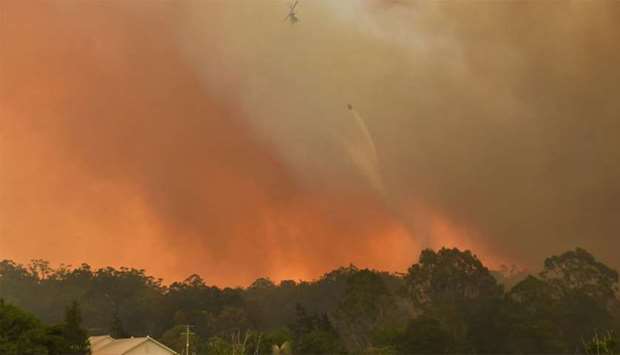At least 13 ferocious bushfires are burning at emergency level across the eastern Australian state of New South Wales (NSW), with one blaze just 20 kilometres outside Sydney.
NSW Rural Fire Service (RFS) had issued an emergency warning for a bushfire burning at South Turramurra on Sydney's upper north shore.
After a massive aircraft dropped phosphate-based red and pink fire retardant on homes being threatened by the raging flames near the bushland, it was later downgraded to advice level. Police declared the area a crime scene as they investigate how the fire started.
According to RFS, there are more than seven dozen fires burning across the state, with 46 still out of control, on Tuesday evening.
Sydney and nearby regions continue to brace for what officials are calling ‘catastrophic fire danger,’ with hot and dry weather, temperatures in the high 30s Celsius and strong winds of up to 80 kilometres per hour.
More than 600 primary to high schools are closed across NSW, the most populous state in Australia.
The state has seen dozens of devastating bushfires since last week, forcing the authorities to declare a state of emergency for a week.
Another ‘very large bushfire’ near Sydney at an emergency level was at Gosper Mountains, some 120 kilometres from city, which is ‘burning through forested country,’ and is being helped by hot, dry and strong winds, according to fire authorities.
Blazes categorized as ‘emergency,’ the highest in the alert level, mean the fire is spreading quickly and it is too late to leave.
More than 3,000 firefighters, hundreds of fire trucks and 80 aircraft have been deployed or are on standby, according to RFS Commissioner Shane Fitzsimmons.
‘We still have many hours yet of these strong dry winds to dominate and influence weather and fire behaviour,’ Fitzsimmons said in a press conference on Tuesday evening.
‘We've still got the southerly change expected to move through later tonight, across the fire grounds still burning up in northern NSW.’
He also said several properties have been destroyed and the number was expected to increase and that several people were injured, including a firefighter who had a case of severe smoke inhalation.
Sydney and much of NSW has been choked by dust and smoke, with very little visibility in many areas and no sign of rain relief, which has hampered efforts by the firefighters.
Some of the fire danger region includes national parks, threatening local wildlife. According to Koala Conservation Australia, fires in the past weeks have already killed 350 koalas and destroyed a few major koala habitats, especially in the state's north-east.
Since last week, when the latest round of bushfires started, at least three people have died and some 100 people including 20 firefighters have been injured.
More than 150 homes have been damaged and almost 1 million hectares of land have burnt already, close to combined total for the last three fire seasons.
In catastrophic fire conditions, ‘fires start and take hold, will grow and develop extremely quickly and will burn very aggressively,’ Fitzsimmons said on Tuesday.
A state of emergency gives the Rural Fire Service and its commander extensive power to mobilize all state resources, manage evacuations, shut down gas, electricity, oil and water services, as well as stop, start, or make use of any businesses, facilities, or premises.
Meanwhile, in Queensland, 57 bushfires are burning but none are at emergency level, with more than 1,500 firefighters on the ground and 40 aircraft on stand by.
The state has also announced a state of emergency in large parts of Queensland, but the situation is not considered catastrophic.
Also, Rally Australia, the final round of the World Rally Championship this year, due to take place this weekend, has been cancelled due to the threat of bushfire near the venue in northern NSW.



